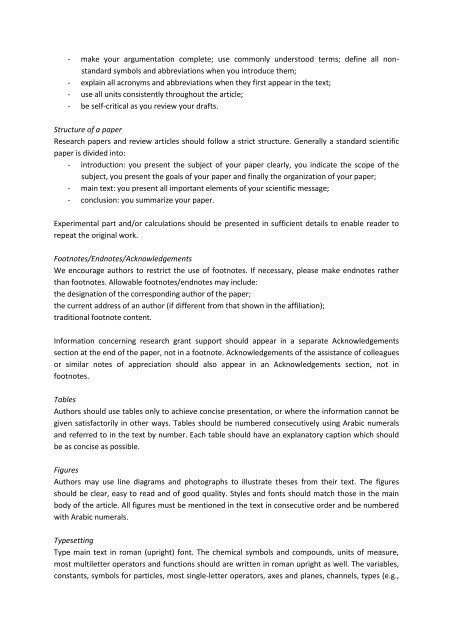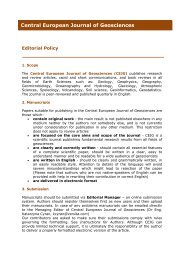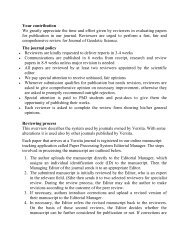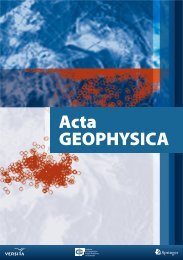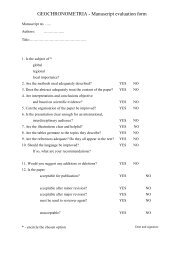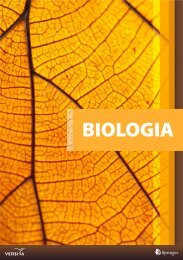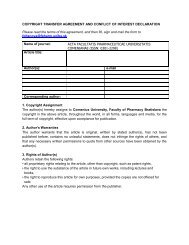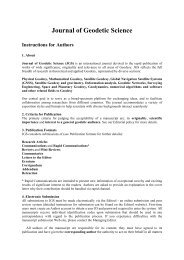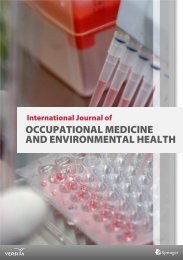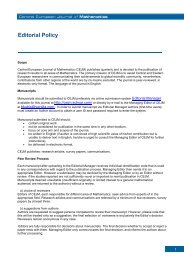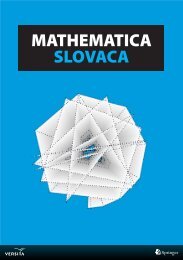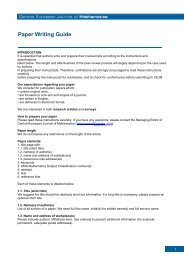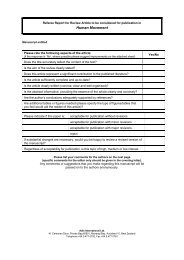(CEJP) Paper Writing Guide - Versita
(CEJP) Paper Writing Guide - Versita
(CEJP) Paper Writing Guide - Versita
Create successful ePaper yourself
Turn your PDF publications into a flip-book with our unique Google optimized e-Paper software.
- make your argumentation complete; use commonly understood terms; define all nonstandard<br />
symbols and abbreviations when you introduce them;<br />
- explain all acronyms and abbreviations when they first appear in the text;<br />
- use all units consistently throughout the article;<br />
- be self-critical as you review your drafts.<br />
Structure of a paper<br />
Research papers and review articles should follow a strict structure. Generally a standard scientific<br />
paper is divided into:<br />
- introduction: you present the subject of your paper clearly, you indicate the scope of the<br />
subject, you present the goals of your paper and finally the organization of your paper;<br />
- main text: you present all important elements of your scientific message;<br />
- conclusion: you summarize your paper.<br />
Experimental part and/or calculations should be presented in sufficient details to enable reader to<br />
repeat the original work.<br />
Footnotes/Endnotes/Acknowledgements<br />
We encourage authors to restrict the use of footnotes. If necessary, please make endnotes rather<br />
than footnotes. Allowable footnotes/endnotes may include:<br />
the designation of the corresponding author of the paper;<br />
the current address of an author (if different from that shown in the affiliation);<br />
traditional footnote content.<br />
Information concerning research grant support should appear in a separate Acknowledgements<br />
section at the end of the paper, not in a footnote. Acknowledgements of the assistance of colleagues<br />
or similar notes of appreciation should also appear in an Acknowledgements section, not in<br />
footnotes.<br />
Tables<br />
Authors should use tables only to achieve concise presentation, or where the information cannot be<br />
given satisfactorily in other ways. Tables should be numbered consecutively using Arabic numerals<br />
and referred to in the text by number. Each table should have an explanatory caption which should<br />
be as concise as possible.<br />
Figures<br />
Authors may use line diagrams and photographs to illustrate theses from their text. The figures<br />
should be clear, easy to read and of good quality. Styles and fonts should match those in the main<br />
body of the article. All figures must be mentioned in the text in consecutive order and be numbered<br />
with Arabic numerals.<br />
Typesetting<br />
Type main text in roman (upright) font. The chemical symbols and compounds, units of measure,<br />
most multiletter operators and functions should are written in roman upright as well. The variables,<br />
constants, symbols for particles, most single-letter operators, axes and planes, channels, types (e.g.,


